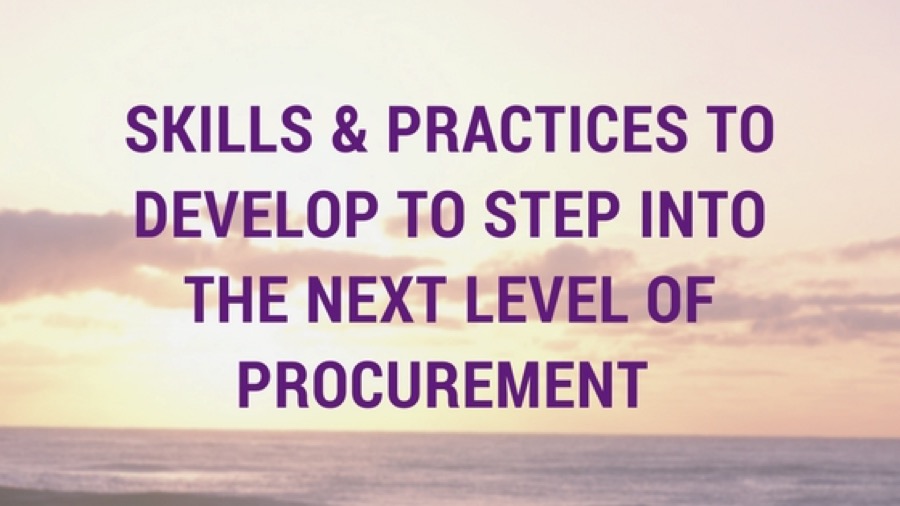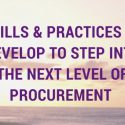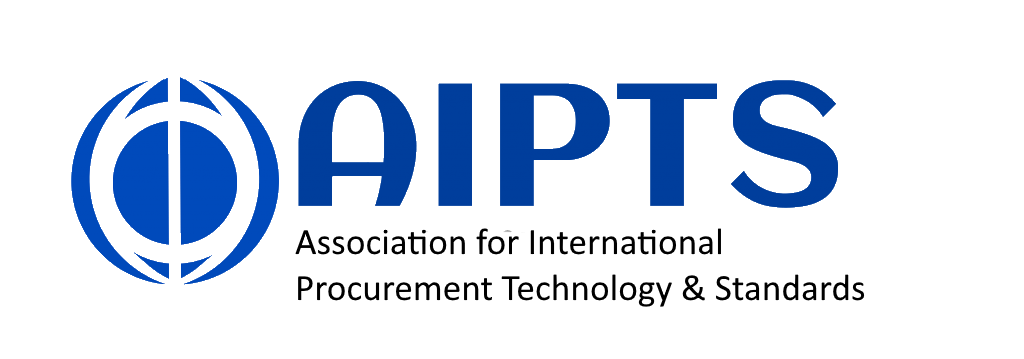This post originally appeared on thunderquote.com

Education is not the preparation for life; education is life itself – John Dewey
Developing skills in any industry is crucial to ensure that you and your company stay ahead of the game. However, in the world of procurement, everything moves so much faster, and there are so many processes that are involved that you are not given the leeway to fall behind. After many interviews with procurement leaders in the region, we put together a list of the best skills and practices that you need to develop in procurement to allow for you and your team to stay ahead in this demanding industry.
One point that was repeatedly raised in the interview series was the need to increase technical and strategic skills within the procurement team to adapt to the changing demands of procurement beyond being just a cost savings function.
Some of the skills that we should include into the daily practice as a procurement team are as follows :
-
Understanding Your Company’s Supply Chain
Procurement’s understanding of the whole supply/value chain is critical because it will allow you to have a more long term and much broader view of your systems. This understanding allows you to apply higher analytical thinking to solve problems, as you begin to see the organisation as a whole system rather than having a myopic view from a single department’s standpoint.
Building upon your understanding, you can start asking questions beyond your traditional cost-related KPIs. How can procurement help with generating revenue as well as cutting costs? Developing this ability to look beyond your pre-set role as a cost-saver is the first step to moving your procurement function into a next level organisation.
Your stakeholders and decision makers are more likely to provide the necessary support and resources for your procurement function to further explore value-adding opportunities beyond cost-cutting. This begins with the understanding of the entire value-chain and looking out for opportunities for revenue generation and value-add.
-
Start Thinking About Sustainability Today
Sustainability should not be an afterthought but rather one in the forefront. We should not be treating sustainability as an add on but rather an integration into the core of your business. It should be discussed not as an initiative but a core ingredient to your procurement process. Sustainable procurement is the way forward, and it should be considered as a core fundamental of procurement.
The impact of sustainability is beyond altruistic outcomes of a better world. Practically, sustainability in your procurement process can make or break your business. The underlying idea behind the pursuit of sustainability is risk management. We may gain short-term benefits from having a cheaper supplier today. However, when they are found to be exploiting child labour tomorrow, your organisation may be left with a stain in your supply chain that will probably cost you more than the initial cost-savings you enjoyed.
It is never too early to think about sustainability and exploring procurement processes and systems that place a firm hold on sustainability issues.
-
Build Strategic Relationships with Your Suppliers.
Another way to stay on top of your game is always to stay connected to external developments in innovations. You can do this by investing in building your relationships with your strategic suppliers. Your suppliers are a great source of new ideas and innovations to improve the way you do things. For example, your IT vendor may be able to suggest new products which could value-add to your organisational processes.
The first step in achieving such a relationship is identifying which suppliers are strategic to your business. An excellent tool to use to determine your strategic vendor-partners is the Kraljic Matrix. Keep close contact with your strategic suppliers because at the end of the day you both need each other to survive. One cannot thrive without the other.
Second, you need to be highly transparent about your business with your strategic vendors. This is very important as it allows you and your vendor to have a better understanding of each other’s business thereby allowing for deeper collaboration and discovery of value-adding opportunities.
World-class procurement organisations achieve this with great success because of one secret – their mindset towards supplier relationships. Unlike many others, they view suppliers as a core business partner rather than merely a seller with a transactional relationship. Therefore, they are able to build a strong relationship with and grow alongside their vendors.
-
Give Priority to Networking
You could also ensure that your team goes to a lot of tradeshows and conferences to benchmark your organisation against other companies. This will make sure that you break out of your bubble of doing things, allow you to see different possibilities in value-adding to your business, and even find solutions for problems that could have taken you longer to solve otherwise.
In procurement, we often get caught up in fixing problems using the ways we are familiar with. This might limit our vision and prevent us from accessing more efficient methods which our functional peers in other organisation have already been utilising.
-
Focus on Developing Commercial Intelligence
Commercial Intelligence (CI) is the process of defining, gathering, analysing and distributing accurate and relevant intelligence regarding the products, customers, competitors, business environment and the organisation itself. – Wikipedia
The most common concern among procurement leaders, when asked about missing skills within their procurement teams, was the lack of understanding of the business as a whole. Procurement professionals need to understand the business needs and gaps by developing a strong connection with the stakeholders and leaders of the company. Without understanding the business of the organisation and their stakeholders’ needs, it is challenging for procurement to break beyond the identity of a cost-cutting function.
Ultimately, bringing procurement to the next level is a shift in mindset from treating the role as being a cost-saver to one that value-adds beyond the dollars and cents. The success of this transformation depends on simultaneous mindset changes in the upper management and the procurement team. We can start by looking at procurement as a value-generator on top of being a cost-saver and developing the skills and practices as introduced in this article.


